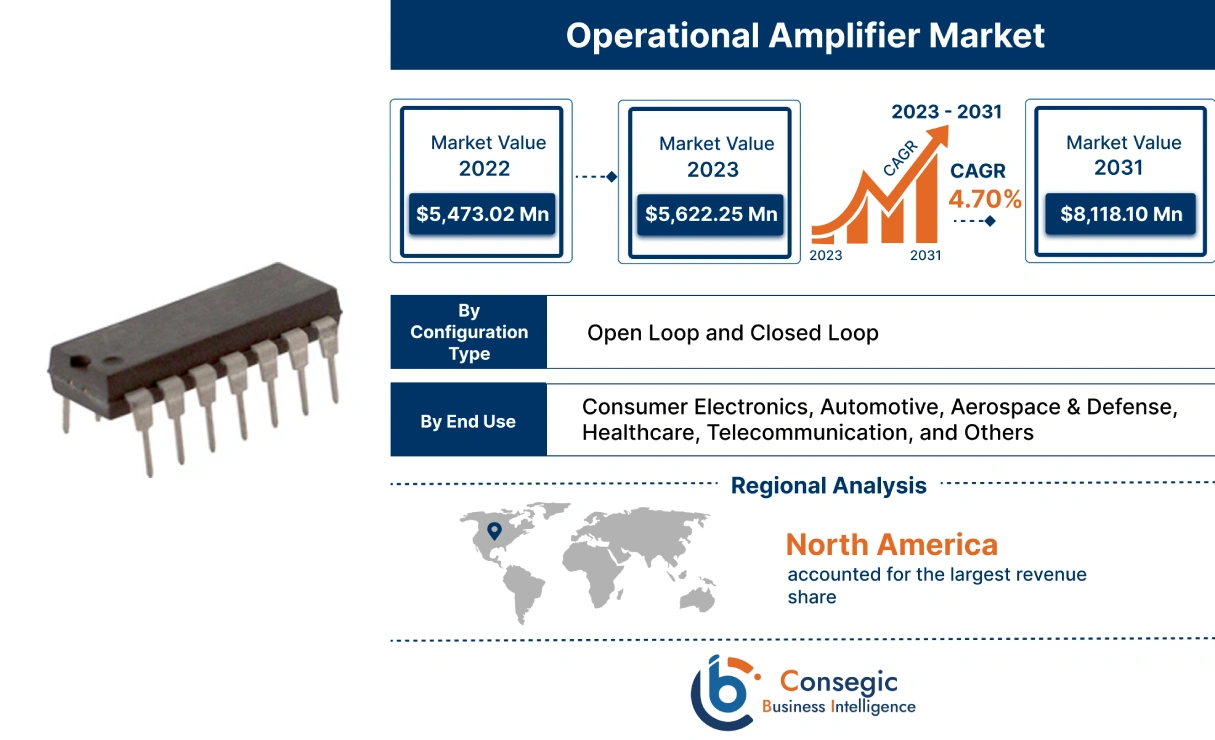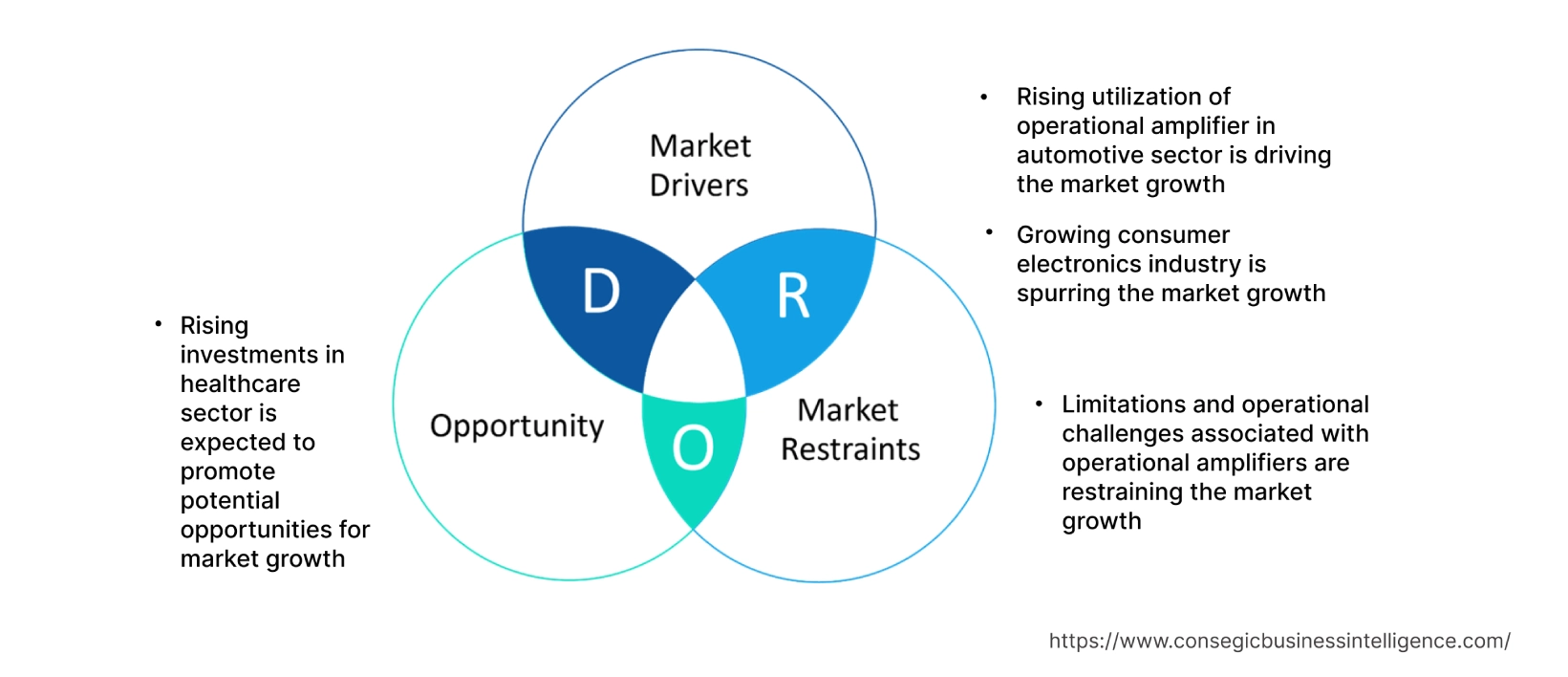- Summary
- Table Of Content
- Methodology
Operational Amplifier Market Size :
Operational Amplifier Market size is estimated to reach over USD 8,118.10 Million by 2031 from a value of USD 5,473.02 Million in 2022 and is projected to grow by USD 5,622.25 Million in 2023, growing at a CAGR of 4.70% from 2023 to 2031.
Operational Amplifier Market Scope & Overview:
Operational amplifiers refer to integrated circuits that are designed for amplifying weak electric signals. They typically consist of two input pins and one output pin. The primary function includes amplification and generation of the voltage difference between the two input pins. Moreover, they offer several benefits including improved input impedance, high circuit stability, reduced output impedance, and increased frequency bandwidth at constant gain among others. The aforementioned benefits are key determinants for increasing their utilization in consumer electronics, automotive, aerospace & defense, healthcare, telecommunications, and other industries.
Operational Amplifier Market Insights :
Key Drivers :
The rising utilization in the automotive sector is driving the market
Operational amplifiers are primarily used in the automotive sector, particularly in applications including automobile electronics involving sensors, infotainment systems, advanced driver assistance systems (ADAS), and others. The ability to obtain high-speed response during signal amplification and high stability to ensure signal precision at the output makes it ideal for utilization in the automotive sector.
Factors including advancements in autonomous driving systems, increasing production of automobiles, and rising demand for enhanced automobile sensor solutions are driving the automotive sector.
According to the International Organization of Motor Vehicle Manufacturers analysis, the total automotive production across the world reached 85.01 million in 2022, representing an incline of 6% in contrast to 80.14 million in 2021.
Additionally, according to the European Automobile Manufacturers Association, total production of passenger cars in the EU (Europe Union) reached 10.9 million in 2022, depicting an incline of 8.3% in comparison to 2021. Therefore, the rising automobile production is increasing the utilization for application in automobile sensors, infotainment systems, advanced driver assistance systems, and others, in turn driving the operational amplifier market growth.
Growing consumer electronics sector is spurring the market
Operational amplifiers are used in consumer electronics in a range of applications including smartphones, stereo systems, television, and other related consumer appliances. They are used in consumer devices for amplifying weak electrical current in a circuit. Moreover, they offer a range of benefits including high input impedance, high gain, high slew rate, low output impedance, and others. The above benefits are key trends for increasing their utilization of consumer electronics.
Factors including advancements in consumer electronics including artificial intelligence and the internet of things, rising penetration of smartphones, television, and other consumer devices, and growing demand for smart energy-efficient devices are driving consumer electronics.
According to the Association of German Banks analysis, the electronics sector in Germany witnessed a substantial rise in 2021. The manufacturing and nominal sales of the German electronics sector attained a significant progression of 10% in 2021 in contrast to 2020.
Additionally, according to Japan Electronics and Information Technology, the total production by the Japanese electronics sector reached USD 95.2 billion in 2021, witnessing a YOY of 9.9% in comparison to 2020. Thus, the rising electronics sector is driving the operational amplifier market growth.
Key Restraints :
Limitations and operational challenges are restraining the market
The utilization of operational amplifiers is usually associated with a few limitations and operational challenges, which is a key factor limiting the operational amplifier market.
For instance, they usually have a limited bandwidth, which may generate issues in certain applications. Moreover, they have high offset values that often lead to errors in the output signal. Similarly, the high input bias current generates errors in the input signals.
Additionally, their performance is prone to be affected by several physical limitations including voltage supply limitations, input offset voltage limitations, short circuit output limitations, slew rate limitations, limited common mode rejection ratio, and others. Therefore, the aforementioned limitations and operational challenges are constraining the market.
Future Opportunities :
Rising investments in the healthcare sector are expected to promote potential opportunities for the market
The rising investments in the healthcare sector are expected to present potential operational amplifier market opportunities. They are often used in the healthcare sector, primarily in medical equipment for amplifying and conditioning the signals obtained from sensors integrated into medical devices. Moreover, they are used in medical equipment including monitoring, diagnostics, imaging, therapy, and other medical instrumentation.
The analysis also shows that the factors including the trend in healthcare expenditure, increasing incidence of diagnostics and surgical procedures, and rising investments in advanced medical equipment are projected to facilitate lucrative prospects for the market.
For instance, according to the American Medical Association, the overall healthcare spending in the U.S. was valued at USD 4.3 trillion in 2021, representing an incline of 2.7% as compared to 2020. Additionally, healthcare expenditure in the United States accounted for 18.3% of the total GDP in 2021. Further, the European Commission invested approximately USD 6 billion budget for the 2021-27 period to support the healthcare sector in Europe.
Therefore, rising investments in the healthcare sector are anticipated to increase the application of medical equipment such as monitoring, diagnostics, and imaging equipment, in turn fostering operational amplifier market opportunities during the forecast period.
Operational Amplifier Market Report Insights :
| Report Attributes | Report Details |
| Study Timeline | 2017-2031 |
| Market Size in 2031 | USD 8,118.10 Million |
| CAGR (2023-2031) | 4.70% |
| By Configuration Type | Open Loop and Closed Loop |
| By End-User | Consumer Electronics, Automotive, Aerospace & Defense, Healthcare, Telecommunication, and Others |
| By Region | North America, Europe, Asia-Pacific, Latin America, and Middle East & Africa |
| Key Players | Texas Instruments Incorporated, STMicroelectronics, Semiconductor Components Industries LLC, Analog Devices Inc., Renesas Electronics Corporation, NXP Semiconductors, Microchip Technology Inc., Cirrus Logic Inc., KEC Holdings, Apex Microtechnology, Honeywell International Inc. |
Operational Amplifier Market Segmental Analysis :
By Configuration Type :
Based on the configuration type, the market is bifurcated into open loop and closed loop. The open loop segment accounted for the largest revenue share in the year 2022 of the total operational amplifier market share. Open loop configuration systems have no feedback components, and their output does not influence their operation and inputs. The open-loop configuration enables input signals to be applied directly to the input of the transistor. The output signal from the transistor is further amplified and applied to the load. Moreover, open loop configuration offers various benefits including reduced distortion, smaller size, and reduced offset output voltage along with reductions in the effect of supply voltage and temperature variations on the output. Analysis shows that these amplifiers with open loop configurations are primarily used in electronics, automotive, and other industries.
For instance, Texas Instrument Incorporated provides OPA167x operational amplifiers with open loop configuration in its product portfolio. They feature low noise, and low distortion, and are primarily designed for application in the automotive and electronics industries among others. Thus, the rising availability of these amplifiers with open loop configurations for utilization in electronics, automotive, and other industries is a prime factor proliferating the segment trends.
The closed loop segment is anticipated to register the fastest CAGR during the forecast period. Closed-loop configuration systems are capable of connecting the system's inputs to its output through a feedback path. The feedback has either a constructive or degenerative effect on the output levels of the system. The response of these amplifiers is often characterized by a transfer function that represents a system's gain and the relation between inputs and output. Moreover, analysis depicts that the primary benefit of these amplifiers with a closed-loop configuration includes the ability to stabilize and regulate its operation through the feedback loop.
For instance, Analog Devices Inc. offers AD844 operational amplifiers with closed-loop configuration. They offer high bandwidth and faster large signal response with superior performance. Therefore, the increasing development of these amplifiers with closed-loop configurations for utilization in industrial applications is a vital factor expected to drive operational amplifier market trends.
By End-User :
Based on the end-user, the market is segregated into consumer electronics, automotive, aerospace & defense, healthcare, telecommunication, and others. The consumer electronics segment accounted for the largest revenue share of 34.4% in 2022 of the overall operational amplifier market share. Factors including advances in consumer electronics including the Internet of things and artificial intelligence, rising penetration of smartphones, television, and other consumer devices, and growing demand for smart energy-efficient devices are driving the growth of the consumer electronics segment.
For instance, according to the Brazilian Electrical and Electronics Industry Association, the electronics sector in Brazil was valued at USD 42.2 billion in 2022, representing an increase of almost 8% in contrast to USD 39.2 billion in 2021. Therefore, the growing consumer electronics sector is driving to amplify weak electrical current in circuits of consumer devices, in turn proliferating the market trends.
The automotive segment is expected to witness the fastest CAGR during the forecast period. The growth of the automotive segment is attributed to several factors including advancements in autonomous driving systems, increasing production of automobiles, and rising demand for enhanced automobile sensor solutions among others.
Operational amplifiers are used in the automotive industry for applications including automobile electronics involving sensors, infotainment systems, advanced driver assistance systems (ADAS), and others.
For instance, STMicroelectronics offers a range of amplifiers designed for automotive applications in its product portfolio. The automotive-grade amplifiers provide high reliability and quality along with compliance with the Automotive Electronics Council (AEC-Q100 and Q101). Additionally, Renesas Electronics Corporation offers a UPC842AMP operational amplifier that is optimized for a wide range of automobile sensor applications. This amplifier can achieve high-speed response time and high stability. Thus, the rising development for utilization in automotive applications is driving the operational amplifier market trends.
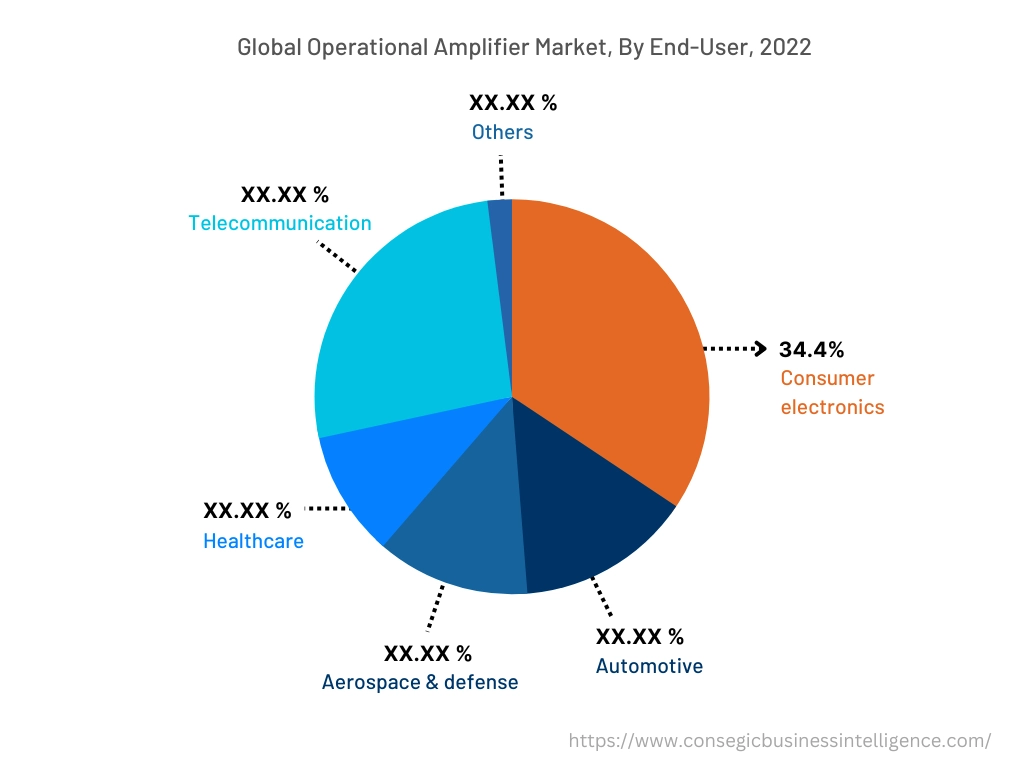
By Region :
The regional segment includes North America, Europe, Asia Pacific, the Middle East and Africa, and Latin America.
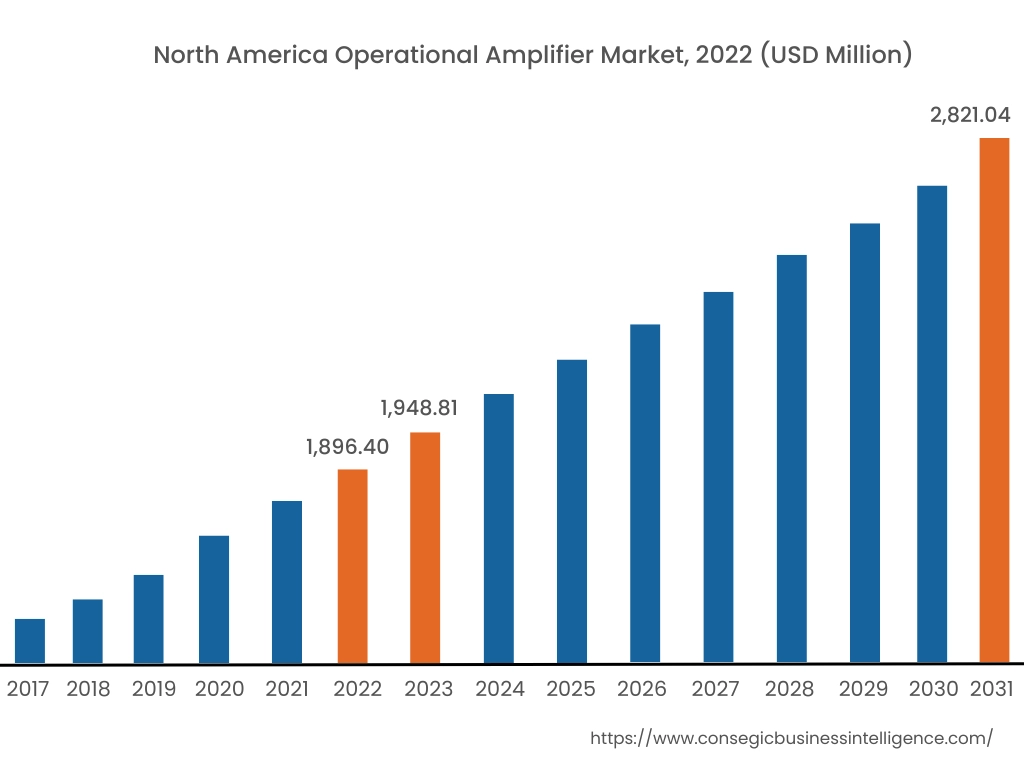
North America accounted for the largest revenue share of USD 1,896.40 Million in 2022 and is expected to reach USD 2,821.04 Million by 2031, registering a CAGR of 4.7% during the forecast period. Also, the market is projected to garner revenue of USD 1,948.81 million in the year 2023. In addition, in the region, the U.S. accounted for the maximum revenue share of 58.65% in the same year. As per the operational amplifier market analysis, the adoption of these amplifiers in the North American region is mostly driven by its utilization in automotive, aerospace & defense, healthcare, and other sectors. Moreover, the rising automobile production and increasing utilization in automobile sensors, infotainment systems, and ADAS for driver assistance are among the significant factors driving the operational amplifier market demand and trends.
For instance, according to the International Organization of Motor Vehicle Manufacturers, the overall automobile production in the North American region reached 14,798,146 units in 2022, witnessing an increase of 10% in contrast to 13,467,065 units in 2021. Thus, the automotive industry is boosting the deployment of these amplifiers, in turn accelerating the market in the North American region. Additionally, increasing investments in electric vehicles and the healthcare sector are anticipated to promote lucrative growth aspects for the market in North America during the forecast period.
Asia-Pacific is expected to register the fastest CAGR of 4.9% during the forecast period. The growing pace of industrialization and development is creating lucrative growth aspects for the market in the region. Additionally, analysis shows that the factors including the expansion of various industries including consumer electronics, telecommunication, automotive, and others are driving the operational amplifier market demand in the Asia-Pacific region.
For instance, according to the India Brand Equity Foundation, the consumer electronics sector in India was valued at USD 9.84 billion in 2021, and it is estimated to grow at a significant rate to reach USD 21.18 billion by the end of 2025. Therefore, the growing consumer electronics sector is anticipated to drive the utilization of these amplifiers for amplifying weak electrical current in circuits of consumer devices, thereby, proliferating the market growth in the Asia-Pacific region during the forecast period.
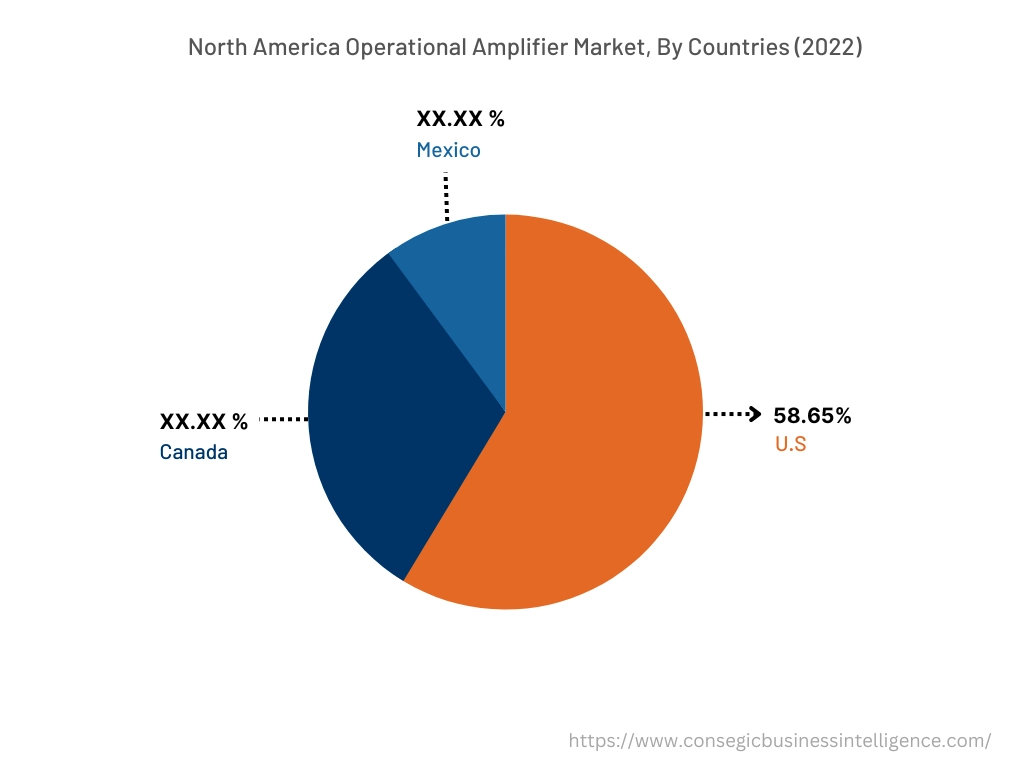
Top Key Players & Market Share Insights:
The operational amplifier market is highly competitive with major players providing these amplifiers to the national and international markets. Key players are adopting several strategies in research and development (R&D), product innovation, and end-user launches to hold a strong position in the operational amplifier market. Key players in the operational amplifier industry include-
- Texas Instruments Incorporated
- STMicroelectronics
- Cirrus Logic Inc.
- KEC Holdings
- Apex Microtechnology
- Honeywell International Inc.
- Semiconductor Components Industries LLC
- Analog Devices Inc.
- Renesas Electronics Corporation
- NXP Semiconductors
- Microchip Technology Inc.
Recent Industry Developments :
- In August 2023, Apex Microtechnology launched a new precision power operational amplifier, PA198. PA198 is designed for output currents up to 200 mA and has a remarkably high slew rate.
Key Questions Answered in the Report
What is operational amplifier? +
Operational amplifiers refer to integrated circuits that are designed for amplifying weak electric signals.
What specific segmentation details are covered in the operational amplifier report, and how is the dominating segment impacting the market growth? +
For instance, by configuration type segment has witnessed open loop as the dominating segment in the year 2022, owing to its increasing utilization in electronics and automotive industries among others.
What specific segmentation details are covered in the operational amplifier market report, and how is the fastest segment anticipated to impact the market growth? +
For instance, by end-user segment has witnessed automotive as the fastest-growing segment during the forecast period due to rising adoption of operational amplifier in automotive sector for application in automobile sensors, infotainment system, and others.
Which region/country is anticipated to witness the highest CAGR during the forecast period, 2023-2031? +
Asia-Pacific is anticipated to register fastest CAGR growth during the forecast period due to rapid pace of industrialization and growth of multiple industries such as consumer electronics, telecommunication, automotive, and others.
